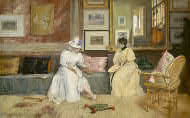
|
William Merritt Chase (artist) American, 1849 - 1916 A Friendly Call, 1895 oil on canvas Overall: 76.5 x 122.5 cm (30 1/8 x 48 1/4 in.) framed: 100 x 145.7 x 7.6 cm (39 3/8 x 57 3/8 x 3 in.) Chester Dale Collection 1943.1.2 |
Object 2 of 7
A Friendly Call takes place in William Merritt Chase's own studio at his summer home near Shinnecock, Long Island. A new vogue for Oriental aesthetics accounts for the bamboo chair, reed floor mats, and silk wall hangings. Such elegance transforms a functional workroom into a private exhibition gallery. This recent rise in the social status of painters had been brought about by the "art for art's sake" movement.
The painter's wife, Alice Gerson Chase, greets an unidentified caller. According to the rigid social etiquette of the 1890s, the hostess has not yet asked—or may never permit—her guest to relax, put down her parasol, and remove her gloves, hat, and veil.
The ladies lean symmetrically toward each other and the center of the geometric composition with its long, low banquette and carefully arranged cushions and framed pictures. As an impressionist, Chase used the large mirror to capture a soft-focus reflection of the sunlit hallway and stair leading to his airy studio.
In his early twenties, Chase had left Indiana to study abroad, rejoicing, "My God, I'd rather go to Europe than go to heaven!" Later, this easygoing man encouraged so many students in Manhattan, Brooklyn, Philadelphia, and at this Long Island summer studio that he boasted, "I believe I am the father of more art children than any other teacher."
| « | back to gallery | » | continue tour |


